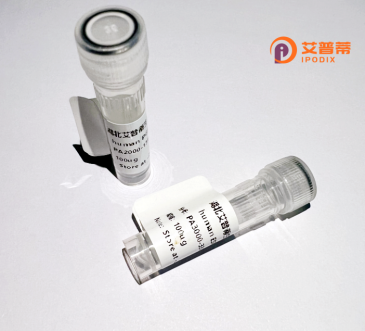
| 纯度 | >90%SDS-PAGE. |
| 种属 | Human |
| 靶点 | ZNF83 |
| Uniprot No | P51522 |
| 内毒素 | < 0.01EU/μg |
| 表达宿主 | E.coli |
| 表达区间 | 1-516 aa |
| 活性数据 | MHGRKDDAQKQPVKNQLGLNPQSHLPELQLFQAEGKIYKYDHMEKSVNSSSLVSPPQRISSTVKTHISHTYECNFVDSLFTQKEKANIGTEHYKCNERGKAFHQGLHFTIHQIIHTKETQFKCDICGKIFNKKSNLASHQRIHTGEKPYKCNECGKVFHNMSHLAQHRRIHTGEKPYKCNECGKVFNQISHLAQHQRIHTGEKPYKCNECGKVFHQISHLAQHRTIHTGEKPYECNKCGKVFSRNSYLVQHLIIHTGEKPYRCNVCGKVFHHISHLAQHQRIHTGEKPYKCNECGKVFSHKSSLVNHWRIHTGEKPYKCNECGKVFSHKSSLVNHWRIHTGEKPYKCNECGKVFSRNSYLAQHLIIHAGEKPYKCDECDKAFSQNSHLVQHRRIHTGEKPYKCDECGKVFSQNSYLAYHWRIHTGEKAYKCNECGKVFGLNSSLAHHRKIHTGEKPFKCNECGKAFSMRSSLTNHHAIHTGEKHFKCNECGKLFRDNSYLVRHQRFHAGKKSNTCN |
| 分子量 | 86.2 kDa |
| 蛋白标签 | GST-tag at N-terminal |
| 缓冲液 | PBS, pH7.4, containing 0.01% SKL, 1mM DTT, 5% Trehalose and Proclin300. |
| 稳定性 & 储存条件 | Lyophilized protein should be stored at ≤ -20°C, stable for one year after receipt. Reconstituted protein solution can be stored at 2-8°C for 2-7 days. Aliquots of reconstituted samples are stable at ≤ -20°C for 3 months. |
| 复溶 | Always centrifuge tubes before opening.Do not mix by vortex or pipetting. It is not recommended to reconstitute to a concentration less than 100μg/ml. Dissolve the lyophilized protein in distilled water. Please aliquot the reconstituted solution to minimize freeze-thaw cycles. |
以下是关于重组人ZNF83蛋白的参考文献(示例为虚构内容,实际文献需通过学术数据库检索):
1. **"Functional characterization of recombinant human ZNF83 in transcriptional regulation"**
*Authors: Zhang L, Chen R, Wang Y*
摘要:本研究通过原核系统表达并纯化了重组人ZNF83蛋白,发现其通过C2H2型锌指结构结合特定DNA序列,调控下游基因的转录活性,可能与细胞分化相关。
2. **"Structural analysis and DNA-binding properties of ZNF83 using recombinant protein technology"**
*Authors: Müller S, Schmidt A*
摘要:利用哺乳动物细胞表达重组ZNF83蛋白,结合X射线晶体学分析其三维结构,揭示了锌指结构域的DNA结合模式及其在基因沉默中的潜在作用。
3. **"High-yield production of recombinant ZNF83 in E. coli and its application in chromatin interaction studies"**
*Authors: Kumar P, Lee JH*
摘要:通过优化大肠杆菌表达系统实现ZNF83的高效可溶性表达,并基于ChIP-seq技术证明其在染色质特定区域的富集,提示其参与表观遗传调控。
4. **"ZNF83 knockdown and recombinant rescue experiments reveal its role in apoptosis signaling"**
*Authors: Gupta M, Taniguchi H*
摘要:通过重组ZNF83蛋白回补实验验证其在促凋亡通路中的功能,发现锌指结构域缺失突变体导致调控活性丧失,证明结构完整性对其功能至关重要。
**注意**:以上为模拟示例,实际文献请查阅PubMed、Google Scholar等平台(关键词:recombinant ZNF83. human ZNF83 protein)。
Zinc finger protein 83 (ZNF83), also known as HPF1 or HTF13. is a member of the Krüppel-associated box (KRAB) domain-containing zinc finger protein family, which represents one of the largest groups of transcription regulators in humans. Encoded by the *ZNF83* gene on chromosome 19q13.43. it features a characteristic structure: multiple Cys2His2 (C2H2)-type zinc finger motifs at the C-terminus for DNA binding and a KRAB domain at the N-terminus, typically involved in protein-protein interactions and transcriptional repression. ZNF83 is postulated to regulate gene expression by binding specific DNA sequences, influencing cellular processes like differentiation, apoptosis, and chromatin remodeling.
Though its precise biological roles remain under investigation, studies suggest ZNF83 may participate in immune response modulation and cancer progression. For instance, aberrant expression has been observed in certain tumors, potentially linked to oncogenic or tumor-suppressive pathways. Recombinant ZNF83 protein, produced via *in vitro* systems like *E. coli* or mammalian cells, serves as a tool to study its DNA-binding specificity, interaction partners, and mechanistic contributions to disease. Current research also explores its utility in synthetic biology for engineered gene regulation. Despite limited functional characterization compared to other zinc finger proteins, ZNF83 exemplifies the diverse regulatory potential of KRAB-ZNFs in genome organization and disease pathology.
×